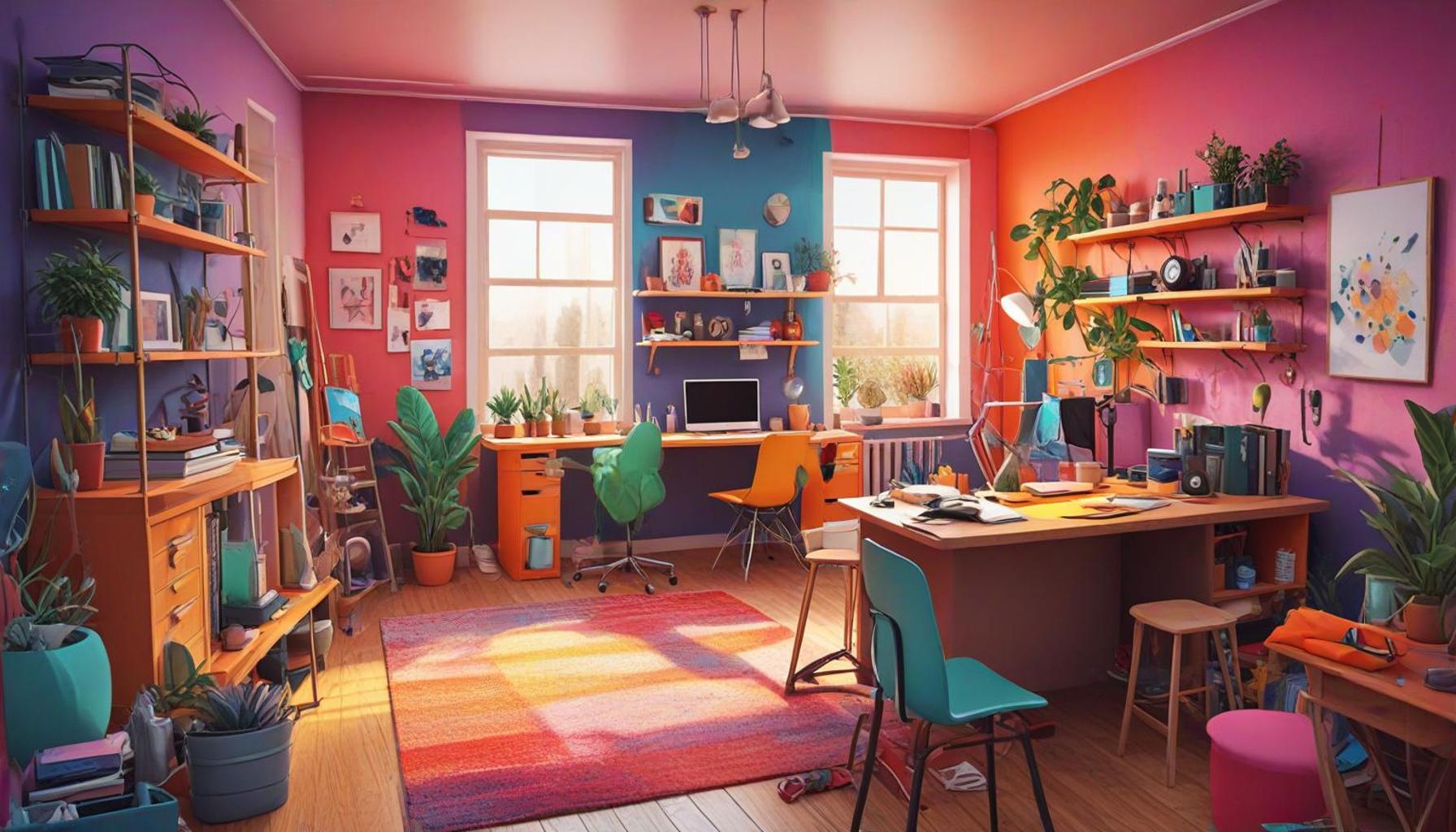Digital Minimalism: How to Reduce Virtual Clutter in Our Lives

The Importance of Digital Minimalism
In an age where notifications ping with relentless frequency, numerous apps vie for our attention, and social media consumes countless hours, it’s increasingly vital to consider how we engage with technology. Digital minimalism presents a philosophy that champions mindful consumption of digital resources, allowing individuals to reclaim their time and focus on what genuinely enriches their lives.
Understanding Digital Clutter
Digital clutter encompasses not just the overwhelming number of apps on our devices but also the perpetual noise created by too many notifications and disjointed online interactions. For instance, a study published in the Journal of Technology in Human Behavior found that excessive smartphone usage is associated with heightened levels of anxiety and depression. Imagine scrolling through numerous feeds only to feel drained and overwhelmed—this is a common consequence of our modern relationship with technology.
Key Components of Digital Minimalism
Embracing digital minimalism requires actionable steps that can lead to transformative change. Here are some strategies:
- Decluttering Digital Devices: Begin with a thorough evaluation of the apps on your phone and the files on your computer. Consider deleting apps that you haven’t used in the last few months. For example, if you find yourself rarely opening certain social media platforms, it might be time to remove them to create a more streamlined digital experience.
- Curating Online Content: Next, refine your online presence by choosing to follow only those sources that provide value or inspire you. Instead of mindlessly scrolling through endless content, subscribe to newsletters that offer meaningful insights, or connect with thought leaders whose work resonates with your interests and goals.
- Setting Boundaries: Consider establishing specific time blocks during your day dedicated to technology use. This might involve designating a no-phone zone during meals or creating “tech-free” hours before bedtime to improve your sleep quality. By setting these boundaries, you can cultivate deeper connections with family and friends in a focused environment.
Benefits of a Minimalist Digital Approach
By adopting the principles of digital minimalism, individuals can experience a profound shift in their overall well-being. Reduced distractions can lead to increased productivity, allowing you to focus on significant projects and hobbies rather than getting sidetracked by constant notifications. Additionally, researchers have found that limiting digital engagement can foster greater mental clarity and emotional resilience.
As we navigate through an increasingly cluttered digital landscape, the call for thoughtful engagement with technology has never been more crucial. Join us as we continue to explore how digital minimalism can empower you to lead a more fulfilling, balanced, and intentional lifestyle.

DISCOVER MORE: Click here to simplify your purchasing process
Recognizing the Signs of Digital Overload
As we delve deeper into the realm of digital minimalism, it’s essential to first recognize the signs of digital overload. Many individuals find themselves on their devices more than they would like to admit. A survey conducted by the Pew Research Center revealed that 85% of American adults own a smartphone, and among these users, a staggering 46% say they feel “overwhelmed” by the information they encounter daily. This sense of being overwhelmed often manifests in the form of stress, anxiety, and a decreased ability to focus.
Common Symptoms of Digital Clutter
Identifying digital clutter can be a crucial first step in adopting a minimalist approach to technology. Here are some common symptoms that may indicate your digital life needs a reset:
- Constant Distractions: If you find yourself frequently checking your phone for notifications or feel the need to respond to messages instantly, this may suggest a lack of control over your digital habits.
- Overwhelming Notifications: A steady flow of notifications can drown out meaningful interactions. If your mobile device dings, buzzes, or flashes continuously, it can disrupt your concentration and contribute to a sense of urgency that’s hard to shake off.
- FOMO (Fear of Missing Out): The push to always stay updated with social media posts or trending topics can lead to continuous scrolling and a crushing fear of missing out on important updates, events, or insights.
- Inability to Unplug: If the thought of spending a day without checking your email or social media fills you with anxiety, it may be time to reevaluate your relationship with technology.
Taking the First Steps Towards Digital Minimalism
Once you’ve recognized the patterns of digital clutter in your life, the next step is to initiate change. Consider starting small. Implementing simple practices can aid in fostering a more balanced relationship with technology. For instance, try setting a daily limit on social media usage or scheduling uninterrupted time for focused work, where all notifications are silenced.
Additionally, engage in regular digital detoxes—designated times where you disconnect from all digital devices. These detox periods can help clear mental space and restore your ability to concentrate. A recent study highlighted that participants who practiced regular digital detoxes reported improved creativity and problem-solving skills.
The journey towards digital minimalism is not an instant transformation but rather an ongoing process of evaluating how technology serves your life. By actively choosing how and when to engage, you can create a more intentional digital experience that aligns with your values and goals.
| Advantages | Description |
|---|---|
| Enhanced Focus | By reducing digital distractions, individuals can better concentrate on tasks, leading to increased productivity. |
| Improved Mental Well-being | Fewer notifications and a clutter-free digital space can lead to reduced anxiety levels and a more peaceful mindset. |
In adopting digital minimalism, individuals often discover significant shifts in their daily routines and overall mental health. The reduction of virtual clutter empowers users to actively manage their digital lives rather than becoming overwhelmed by it. This intentional approach allows one to eliminate unnecessary apps, social media accounts, and notifications that often contribute to feelings of chaos and distraction.Moreover, embracing fewer digital tools can lead to a more enriched experience with those that remain. Instead of mindlessly scrolling, individuals can engage deeply with content that genuinely matters to them. Through this lens, digital minimalism functions not just as a strategy for decluttering, but as a holistic lifestyle shift that prioritizes meaningful interaction over passive consumption.Further exploration into methods such as time-blocking or scheduled device-free hours reveals innovative avenues for people to regain control and establish healthier boundaries with technology. This journey invites readers to rethink their relationship with digital entities and encourages them to uncover the potential benefits awaiting inside a less cluttered virtual landscape.
DON’T MISS: Click here to discover how essentialism can transform your productivity
Strategies for Effective Digital Decluttering
Once you’ve acknowledged the digital clutter overwhelming your life, it’s time to put strategies into action. Here, we delve into practical methods that can significantly enhance your digital minimalism journey.
1. Curate Your Digital Environment
The first step towards a minimalist digital landscape is to curate your digital environment. This involves auditing the apps, subscriptions, and digital tools you utilize. Do you really need that social media app that offers little value? Is that newsletter flooding your inbox with irrelevant information? Start by deleting or unsubscribing from anything that fails to enrich your life or contribute to your goals.
A recent survey found that U.S. adults receive an average of 120 emails a day, many of which go unread. Consider implementing a strategy like the Two-Minute Rule for email: if it takes less than two minutes to respond, take care of it immediately and free up your inbox space. By consciously selecting which tools and platforms are necessary, you can reclaim control over your digital habits.
2. Set Boundaries with Your Devices
Establishing boundaries with your devices is crucial for promoting a balanced approach to technology. Consider utilizing features such as “Do Not Disturb” during designated focus times or while spending quality moments with family and friends. Limiting usage to specific times of the day can help funnel your focus into productive activities rather than mindless scrolling.
For example, experts recommend setting aside specific hours for social media interaction—perhaps after work or during designated breaks. This could help harness your smartphone use toward enjoyment rather than automatic habits. In fact, research indicates that individuals who actively set limits on their screen time report higher levels of satisfaction, decreased stress, and improved focus.
3. Reassess Your Digital Consumption Habits
Beyond limiting notifications and curating your environment, consider conducting an audit of your digital consumption habits. This means reflecting on how you spend your time online and whether those engagements are worthwhile. Platforms like RescueTime can provide insights into your daily habits, revealing which activities consume large portions of your day.
Engaging in this self-reflective practice allows you to identify patterns—such as endless hours on streaming services or social media rabbit holes—that detract from your productivity and well-being. This, in turn, empowers you to make mindful choices about where to allocate your digital energy.
4. Embrace Simple and Minimal Digital Tools
Digital minimalism doesn’t mean cutting technology out entirely; it is about embracing tools that streamline your digital experience. Look for applications and platforms that prioritize simplicity and usability. For example, switching from complex project management tools to simpler to-do list apps like Todoist or Trello can help decrease the feeling of overwhelm.
Additionally, consider using a single platform for social media that aligns with your interests and goals instead of maintaining multiple accounts across several platforms. This way, you can engage meaningfully rather than spreading your attention thin across countless digital spaces.
In the age of information overload, adopting a digital minimalist approach can not only declutter your devices but can lead to an overall enhancement in life quality. By navigating the world of technology with intention, you invite clarity into your everyday life, ultimately paving the way for improved mental health, productivity, and genuine connections.
DISCOVER MORE: Click here for practical tips
Conclusion: Embracing a Simplified Digital Life
In a world filled with constant notifications and overflowing inboxes, digital minimalism emerges as a powerful antidote to the overwhelm of virtual clutter. By embracing intentionality in our digital interactions, we can enhance our mental well-being, boost productivity, and develop meaningful connections. The process begins with a conscious effort to curate our digital environment, shedding unnecessary apps and subscriptions that drain our time and energy. Establishing robust boundaries with technology, such as implementing ‘Do Not Disturb’ modes during family meals or focused work, further protects our attention from needless distractions.
As we reassess our digital consumption habits, tools like RescueTime can shed light on our usage patterns, encouraging mindful engagement rather than passive scrolling. Rather than abandoning technology entirely, the journey of digital minimalism invites us to select simpler, more effective tools that serve our goals, improving our overall quality of life. The principles of digital minimalism challenge us to prioritize depth over breadth in our online experiences, cultivating satisfaction in our virtual interactions.
Ultimately, by committing to this mindful approach, we not only declutter our digital spaces but also create room for creativity, relaxation, and meaningful connections. As we continue navigating this digital age, the pursuit of simplicity may very well hold the key to achieving a balanced, fulfilling life. Explore these methods and take actionable steps toward cultivating your own digital minimalism; the journey to reclaiming your time and attention starts today.



